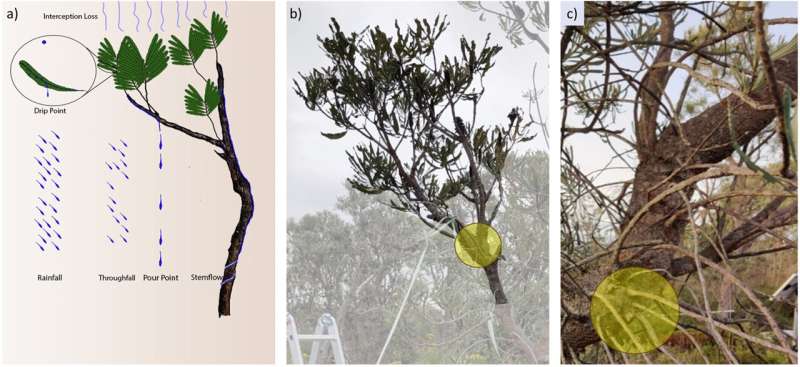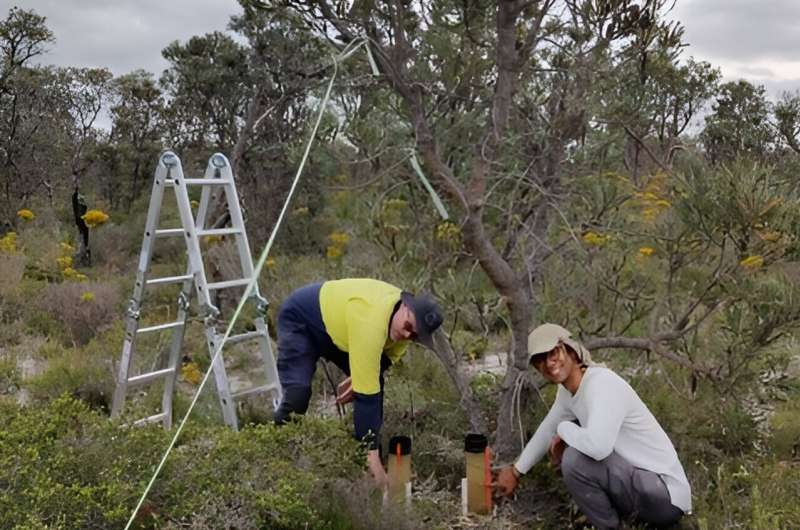March 18, 2024 feature
This article has been reviewed according to Science X's editorial process and policies. Editors have highlighted the following attributes while ensuring the content's credibility:
fact-checked
peer-reviewed publication
trusted source
proofread
Pour points: A novel method for woodland water resource management

Vegetation plays a vital role in regulating the percentage of precipitation reaching the ground to nourish the root systems of plants both in the canopy and undergrowth, which consequently supports the survival of the entire forest ecosystem. Water arrives to the ground via multiple mechanisms, including throughfall (water falling directly through the canopy) or stemflow (water flowing down stems and trunks), while some is intercepted by the canopy leaves and does not reach ground level.
New research, published in Water Resources Research, has focused on pour points, locations where water flowing under the branches detach. These are distinguished from the large drops falling from leaves, known as drip points.
A pour point is formed when the raindrops, initially intercepted by leaves or the top half of the branch, flow to the underside of branches, coalesce with other droplets to form a rivulet, but fall before becoming a part of stemflow.
The detachment of the rivulet can occur where multiple branches converge or where a single branch changes in angle, leading to a pour point. These are important as they considerably increase water received from the canopy to the forest floor at fixed points, thereby supporting enhanced infiltration of water to the ground.
The volume of water received at pour points is impacted by a number of factors, such as the structure of the branches, leaf surface area (foliation), and the volume of rainfall. The larger water droplets occurring at these points have more kinetic energy than normal rainfall, meaning that they create more pronounced dips in the soil upon impact, thus augmenting infiltration efficiency.
Investigating banksia woodlands in Western Australia, Ashvanth Kunadi, a Ph.D. researcher at the University of Western Australia, and colleagues combined field data with rainfall simulation experiments to determine the role of pour points in woodlands that receive limited rainfall, similar to those in other Mediterranean regions (hot dry summers and mild wet winters). Indeed, features of this study have also been observed on fig trees, American beech and oak trees.
Explaining the initial interest in the topic came while sitting under a fig tree during a rain shower, Ashvanth noticed water flowing underneath a branch was "continuously detaching at a certain point and the puddle beneath that point was growing."
"This piqued my interest. There is a water shortage in the southwest of Western Australia, and we rely heavily on groundwater. If trees, instead of just stopping rain, were actually channeling more water to the ground beneath them, then our conception of their impact would fundamentally change."
Further detailing the significance of this research, Ashvanth continued, "I would say that the amount and spatial distribution of rain that falls from the sky is fundamentally altered by the presence of a tree canopy. We don't have a good understanding of 1) where a certain volume of water is going to go and 2) why. Pour points are a gateway to understanding the flow of water on a tree.
"Aside from that grand ambition, areas where rainfall fluxes are concentrated (such as at pour points) 1) create biological hotspots (water is a precondition to life), 2) demarcate sites of enhanced and deeper infiltration, and 3) may represent a significant proportion of the overall flux of rainfall that is reaching the ground (so, if you ignore the flux, you underestimate the amount of water your system is getting and that error propagates further into the analysis)."
The team placed rain gauges below 16 suspected pour points of the two codominant banksia species in the woodlands: Banksia menziesii and Banksia attenuata, and a further six under branches where conditions were not met to create a pour point ('negative' test), over a two-year period. In addition, five Banksia menziesii branches (four with suspected pour points and one 'negative'), were studied under controlled conditions in a rainfall simulation setup.
This rainfall simulation setup proved particularly challenging to maintain all of the variables, as Ashvanth reveals, "There were so many things to keep track of: is the branch angle steady, is the branch swaying, is there enough water in the rainfall simulator, is the pressure constant, have I taken pictures and videos of interesting phenomena, have I defoliated the leaves properly?
"On top of that, the branches were not designed to be cut from the trunk so, if the sun is out, the branch better be wet or it's dead. Consequently, from roughly 8 a.m. to 10 p.m. I would just be doing rainfall simulations… it was absolutely insane but completely worth it."
Banksia leaves have a large surface area, high stiffness, and an angle that facilitates the channeling of water down onto the stems, rather than dripping off the leaves. They found that rain collection from pour points was 1.5 to 15 times that of the surrounding rainfall and throughfall, and was usually greater than stemflow.
From the rainfall simulation experiments, the scientists determined that a branch with high leaf coverage experienced greater flux of water at the pour point. This flux was less sensitive to changes in branch angle. Fluxes from a fully foliated branch seemed insensitive to angle change, but when a third of the leaves were removed partitioning of water between stemflow and pour points was significantly affected by changes in branch angle.

While no conclusive optimum branch angle for pour point initiation was found in this experiment, Ashvanth reveals that this is ongoing work for the research team. "One of the negative test points, where we thought the necessary not sufficient conditions were present had a really small branch angle (~ <5°) change. But this was sufficient to cause a pour point. Though, that doesn't mean any 5° change is going to cause a pour point.
"We are currently working on another paper where we do idealized experiments to answer this exact question. We have used PVC pipe to remove the heterogeneity present on the surface of naturally occurring branches and then made water run on its surface to see what happens. There is also a lot of cool theoretical development there so definitely keep your eye out for that."
Measuring the water content of soil directly below pour points, the research team found 20%–30% of the seasonal rainfall volume infiltrated to a depth of 1 m here, compared to just 5% in control test areas away from pour points. This makes pour points important zones for groundwater recharge and storage in the forest ecosystem, although in the study site one pour point was identified per ~30 m2, matching the distribution of banksia trees, being one pour point per tree on average.
This particular study site in Western Australia is important as it overlies a significant source of groundwater that supplies the population of Perth. Therefore, the ability of pour points to potentially recharge groundwater supplies at this site (and at others via other trees globally), is vital for supporting water resources management both for forests and humanity.
"As a species, we are continuously striving to better understand ourselves and the natural world around us," Ashvanth concludes.
"We conceptualize our understanding of the world as systems, and these systems are necessary simplifications of the infinitely complex world. One of these systems is the water cycle, and interception we believe is potentially the least understood part of the water cycle. If we can predict and understand pour point behavior, we can move closer towards figuring out the flow of water on trees so that we have a better conception of the interception system, and ultimately Earth's water cycle."
More information: Ashvath S. Kunadi et al, Introducing Pour Points: Characteristics and Hydrological Significance of a Rainfall‐Concentrating Mechanism in a Water‐Limited Woodland Ecosystem, Water Resources Research (2024). DOI: 10.1029/2023WR035458
Journal information: Water Resources Research
© 2024 Science X Network





















